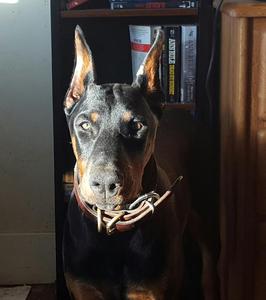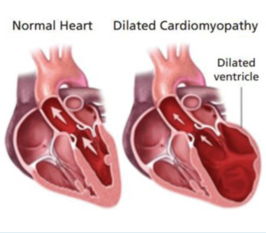DanBar Ranch
In the early 1970s the Doberman became wildly popular. They quickly rose to the number two AKC registered breed. No breed can survive this type of fad popularity without horrific damage being done to the breed's health, type and temperament; all due to poor breeding practices. The Doberman is still trying to recover from years of "backyard" breeding along with decades of show ring breeders flocking to a very few "super studs" which produced show winners - and generations of dogs with genetic diseases. Today the Doberman lover must really do their research in order to avoid heartbreak - and - to be honest, there is still NO guarantee that any pup will not develop some disease at some point in its life. But by supporting responsible breeders you are helping directly to bring this great breed back from the brink.
If you wonder why the Doberman is such an expensive breed, look no further than at the amount of and cost of the health testing absolutely required in order to produce Dobermans with the best chance of being healthy. This is not a breed for the faint of heart or the tight of wallet.
Health Testing: CARDIAC DISEASE (DOBERMAN)
Resources to Educate Yourself on the Number One Health Issue Facing the Doberman
TESTING AVAILABLE FOR CARDIAC DISEASE
Doberman pinschers are one of the most common breeds of dogs to be affected with Dilated Cardiomyopathy (DCM). When a Doberman pinscher is diagnosed with DCM, the implication of subsequent abnormalities, such as congestive heart failure and sudden death become concerns.
For years there has been just one test (DCM1) for 2 mutations known to be connected with Doberman Cardio Myopathy (DCM). However it was known that Dobermans of European breeding were better served by a newer, second test called (DCM2) and only offered by the University of North Carolina. Both of these tests are DNA tests which can be carried out when the Doberman is just born. See more information below.
As well, Dobermans should undergo screening for DCM, consisting of an echocardiogram and a baseline Holter monitor test, starting when dogs are 2 years of age. Dobermans with one or more DCM 1 or 2 mutations should be cleared every 6 months.
The diagnostic tests are used together because one test may produce normal results and the other may pick up on an abnormality, or vice versa. For example, an echocardiogram examines the structure of the heart and detects functional abnormalities at a single segment of time, while the Holter monitor provides information about the heart’s electrical activity over an entire day. Together, these tests help to identify dogs that might later experience sudden death or develop structural disease not already present.
Holter monitor testing involves a dog wearing a vest outfitted with electrodes that record heart rhythm over 24 hours. The testing picks up all normal heartbeats during that time, as well as abnormal heartbeats. Heart rate varies based on a dog’s activities. A sleeping dog’s heart may beat from 28 to 40 times per minute, compared to a rate of 65 to 80 beats per minutes when the dog is awake. The heart may accelerate to 200 beats per minute when a dog is running.
RISK FACTORS OF DCM 1 and DCM 2
The easiest way to picture this is:
Researchers have discovered mutations on 4 genes which are associated with DCM disease in Dobermans. A dog can have anywhere from zero mutations to one, two, three or four. The more mutations, the higher the risk of the dog developing DCM. The best possible result is a "Clear" result for the DCM 1 test which tests for 2 of the mutations, and a "Clear" on the DCM 2 test, which tests for the other 2 mutations. Below is some additional information on risk factors of dogs who have been tested.
Negative Result for both DCM1 and DCM2:
The absence of both mutations in a Doberman indicates that the risk of developing DCM is low. It is still possible for a dog to develop heart disease. However, a negative result for both DCM1 and DCM2 indicates that a dog does not have either mutation known to cause DCM.
Positive result for DCM1 only:
About 40% of dogs with this mutation will develop DCM. Dogs that are positive for only DCM1 will not necessarily develop significant heart disease.
Breeding recommendations:
Dogs are positive for DCM1 should NEVER be bred to a dog that is positive for NCSU DCM 2 since this will lead to dogs that are highest risk of developing DCM. Dogs that are positive homozygous for DCM1 should ideally not be bred.
Positive Result for NCSU DCM2 only:
About 50% of dogs with this mutation will develop DCM. Dogs that are positive for only DCM2 will not necessarily develop significant heart disease.
Breeding recommendations:
Dogs are positive for DCM2 should NEVER be bred to a dog that is positive for NCSU DCM1 (PDK4) since this will lead to dogs that are highest risk of developing DCM. Dogs that are positive homozygous for DCM2 should ideally not be bred.
Positive result for both DCM1 and NCSU DCM2:
Dogs that positive for BOTH DCM1 & DCM2 are at a very HIGH risk of developing DCM and should be carefully monitored by your veterinarian for signs of disease. Annual evaluation by a cardiologist with an echocardiogram and Holter monitor after 3 years of age is recommended.
Breeding recommendations:
Dogs that are positive for both DCM1 & DCM2 are at the HIGHEST risk of developing DCM and should ideally not be bred since they can pass both traits on. They should never be bred to a dog that is positive for either test.
DANBAR RANCH DOBERMANS ARE ALL DCM1 and DCM2 CLEAR.
Hun Siccer (Huni) at 6 months of age.




